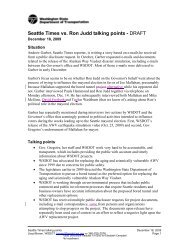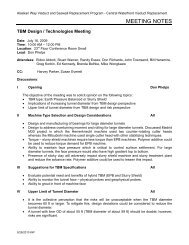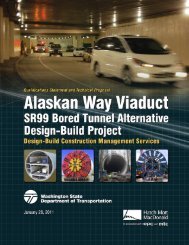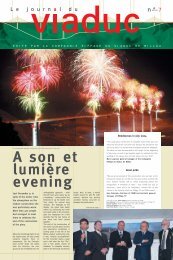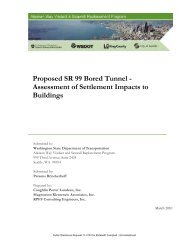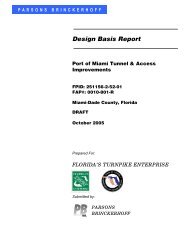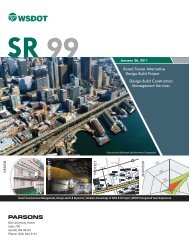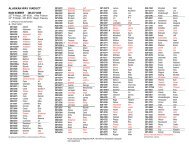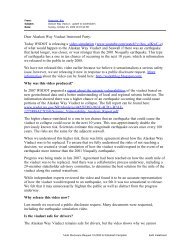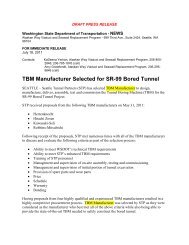080731 6LYG A1 Particular Tunnelling Specification ... - SCATnow
080731 6LYG A1 Particular Tunnelling Specification ... - SCATnow
080731 6LYG A1 Particular Tunnelling Specification ... - SCATnow
You also want an ePaper? Increase the reach of your titles
YUMPU automatically turns print PDFs into web optimized ePapers that Google loves.
Lee Tunnel, Contract No. <strong>6LYG</strong>/<strong>A1</strong><br />
PT – <strong>Particular</strong> <strong>Tunnelling</strong> <strong>Specification</strong> - PT300<br />
PT305.8<br />
PT306<br />
PT306.1<br />
PT306.2<br />
PT307<br />
PT307.1<br />
PT307.2<br />
PT307.3<br />
PT308<br />
PT308.1<br />
PT308.2<br />
PT308.3<br />
All soil conditioning materials, oils, greases, sealing compounds and any other<br />
material injected into or in contact with the soil, rock or ground water which is<br />
used during the mining operation shall be compliant with all relevant regulatory<br />
agencies and the requirements of the Contract.<br />
MINIMUM REQUIREMENTS FOR TBM TUNNELLING EQUIPMENT<br />
With particular reference to this Contract Document, the requirements as<br />
detailed in this Section will not modify or detract in any way whatsoever from the<br />
Contractor’s sole responsibility for the selection, design and operation of the<br />
tunnelling plant and equipment.<br />
The Contractor shall assemble, maintain, operate and remove all tunnelling<br />
equipment necessary to construct and complete the tunnel in accordance with<br />
the Contract Documents and the ground conditions encountered. The Contractor<br />
shall also ensure that the design, manufacture and operation of the tunnel mining<br />
equipment, including the TBM, are carried out in such a manner that the tunnel<br />
can be constructed and completed in accordance with the time of completion<br />
requirements of the Contract.<br />
CUTTERS<br />
Cutter design shall take into account the abrasivity of the ground conditions. The<br />
cutters shall be hard faced to a design giving best wear resistance. Cutters shall<br />
be backloaded such that access for repair and replacement can be carried out in<br />
safe working conditions.<br />
The Contractor shall pay particular attention to protection of the moving (rotating)<br />
elements of the machine against the potentially abrasive nature of the ground.<br />
The TBM shall be equipped with Chromium Carbide abrasion resistant plating or<br />
other approved hard facing to all exposed moving surfaces of the TBM, for<br />
example cutting head and screw conveyor.<br />
Design components for maximum abrasion resistance and durability. Minimize<br />
disc cutter wear to the greatest extent possible when not currently in use to<br />
perform tunnel excavation by such means as designing hubs and bearings to<br />
allow discs to be readily rotated by hand, and by limiting disc cutter projection<br />
beyond the cutter head face.<br />
CUTTER HEAD<br />
The TBM shall incorporate a soil conditioning system for injection directly onto<br />
the face. The screw conveyor (if EPBM closed mode) shall also incorporate a<br />
facility for soil conditioning. Soil conditioning agents shall be bio-degradable and<br />
acceptable for the excavated materials to be used as a fill. All ports shall be<br />
independent.<br />
The TBM shall be capable of excavating through the ground conditions indicated<br />
in the Contract Documents and geological and geotechnical information available<br />
to the Contractor without interruption of the excavation operations<br />
Provide capacity to start cutter head with not less than 1.25 times rated full load<br />
torque. Provide clutches or hydraulic assist for a variable frequency electric drive<br />
(VFD) or use a variable speed hydraulic drive system. Thrust System and<br />
Steering<br />
a) Design TBM to provide forward propulsion by thrust cylinders that react<br />
against the installed segmental liner without damaging the liner.<br />
b) Equip the thrust cylinders with shoes or pads to distribute the jacking forces<br />
to the liner without damaging the liner. Design the thrust cylinder shoes to<br />
be consistent with segment and segment joint design while capable of<br />
individual and synchronized thrust cylinder actuation while limiting the<br />
Thames Water Utilities Limited August 2008<br />
Page 4 of 15




